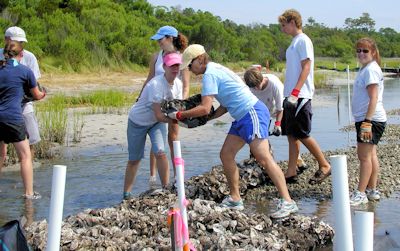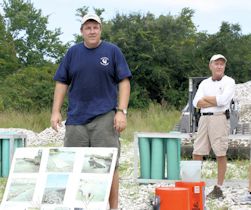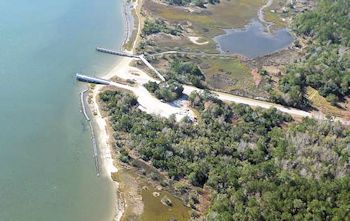 Volunteer stack mesh bags full of oyster shells to make a reef at Morris Landing. |
 This is the result of countless hours of work by hundreds of people. |
HOLLY RIDGE — Ted Wilgis, an educator for the N.C. Coastal Federation, strolled along the marshes of Stump Sound near this small community in Onslow County. He pointed out a strip of shoreline at the federation’s Morris Landing Clean Water Preserve, where the nonprofit group began creating a living shoreline back in 2005. A herd of fiddler crabs skittered from the low-tide water line, across a patch of sand, burrowing into the marsh grass, waiting for the tide to come back and deposit dinner. Dragonflies flitted along the tips of the grass, already eating mosquitoes.
As he talked his way through the reclamation project, pointing with pride to the work done by countless volunteers, Wilgis was constantly reminded of the work yet to be done, not just with the on-going restoration of 52 acres of shoreline and marshland, but with teaching the people who will be needed to insure the project’s success.
Supporter Spotlight
“This blows my mind,” he says, referring to the ongoing eight-year effort to create and restore the preserve.
The work continues, but not in the rain. The federation had planned to gather volunteers at the landing on Saturday and again on July 27. Wilgis cancelled those dates today because of expected bad weather. The new dates are Saturday, Aug. 10, and Tuesday, Aug. 20.
Volunteers will meet at the preserve on Aug. 10 from 10 a.m. to noon, to build another oyster reef. After the work, everyone will let their hair down a bit for what the federation is calling a Community Clean Water Celebration. They can view educational exhibits, enter a cast net throwing contest and win various prizes. The kids can print fish on t-shirts, pull seine nets along the shoreline and compete in a host of games.
On Aug. 20, volunteers will work from 9 a.m. to 2 p.m. placing the remaining 5,000 bags of oyster shells and marl in the water for the second and final day of oyster reef construction.
The second part of the Aug. 10 event is all about having fun while learning something, Wilgis said.
Supporter Spotlight
“We don’t want volunteers to walk away from building an oyster reef, and not understand why they did it and how it works,” he said. “It’s also about understanding the value of that, to feel ownership and stewardship of that project and the coastal environment.”
 Ted Wilgis, left, talks to volunteers before a work session at Morris Landing. |
The Morris Landing site stands, in many ways, as a prime example of how, since its inception in 1982, the federation has worked as an advocate and support group for people who want to take action to protect the coastal environment.
The methodology started to take shape in 1982 when federation founder and executive director, Todd Miller, rallied fisherman and others to successfully fight off speculators who wanted to strip mine peat from the boggy lands between Albemarle and Pamlico sounds. It was brought to bear locally when Lena Ritter, a Stump Sound native and oyster fisher, sought the federation’s help in her five-year fight against developers who wanted to build condominiums on nearby Permuda Island. Ritter won and the island is now preserved as a state sanctuary.
In both instances – and in the many more that were to follow — the federation worked to help local people solve vexing coastal environmental problems.
The best way to protect a place, though, is to buy it. Probably unknown to many of its 10,000 or so members, the federation is one of the most successful land trusts in the state, having preserved more than 10,000 acres of ecologically important land across the coastal plain. There were small parcels, like the 31-acre Hope Pole Creek Preserve in Atlantic Beach and the 20-acre island in the White Oak River that is now part of a state park and is home to an environmental education center. And then there were the huge tracts, like the 6,000 acres of an old farm in eastern Carteret County that is the site of one of the largest wetland restoration projects in the country.
Using a state grant, the federation bought this place, too, when the Boy Scouts of America put it up for sale in 2002.
“The Boy Scouts were using the area for camping,” said Wilgis, “but it was open to the public, as well. People were able to drive up and down the shoreline, but there was a lot of dumping going on.”
 The Morris Landing Preserve. |
With the Federation’s acquisition of the site, that sort of thing has stopped. While still keeping the preserve open for people to enjoy, the Federation stopped the more damaging aspects of public access, partly by building a wooden walkway that restricted vehicle access.
The big picture of the Morris Landing Clean Water Preserve is that it’s a key site for the federation’s and N.C. Division of Marine Fisheries’ strategies to restore oysters, enhance shellfish habitat and manage a sustainable oyster fishery in the highly productive waters of Stump Sound. The restoration part of that process is only part of the story, just as the events scheduled for Saturday are only partly about the volunteers’ creating an oyster reef. The second half of that event – the Community Clean Water Celebration – is about education.
“It’s much more expensive to restore an area than it is to protect it,” Wilgis said. “So, for me, that’s what I look at. This is a very long haul, and there’s a lot of positive stuff going on; working with volunteers, students, by not only engaging them in having fun, but in attaining a sense of accomplishment, too, so they make that connection. That kind of thing will keep you going forever. Those are the things that make this job wonderful.”
You can really make Wilgis’ day by showing up and rolling up your sleeves. Call him for more information at 910-509-2838 or email him








